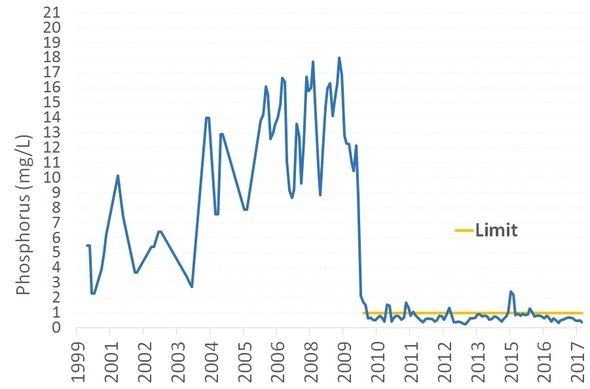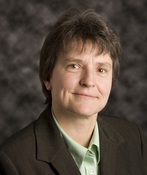|
December 2017
Orwell Lake in Otter Tail County is meeting water quality
standards for nutrients, thanks to major decreases in phosphorus from upstream
wastewater treatment plants.
Orwell
Lake is a 590-acre impoundment on the Otter Tail River in west-central
Minnesota. The lake is a protected
wildlife sanctuary, and is popular for fishing and hunting.
The Pelican Rapids WWTP discharges its effluent to the river 30
miles upstream. More than 10 years ago, the Minnesota Pollution Control Agency (MPCA)
issued a stricter phosphorus limit to the Pelican Rapids WWTP because of
increased algal growth in Orwell Lake. Algal blooms can make water unattractive
for recreation such as boating and unsuitable for fish and other aquatic life.
Since then Pelican Rapids upgraded its facility, and has reduced
its effluent phosphorus concentration and load by more than 90%, from 10-18
mg/L to less than 1 mg/L (chart below).
The city of Fergus Falls also discharges its effluent to the Otter
Tail River, about 10 miles upstream of Orwell Lake. It too upgraded its
facility to meet a stricter phosphorus limit, and has reduced its phosphorus
discharge by about 80%, down to less than 1 mg/L.
Recent water monitoring shows that Orwell Lake is meeting nutrient
water quality standards for lakes. Prior to the phosphorus limits in the
wastewater discharge permits:
-
Phosphorus levels in Orwell Lake were historically at 75 micrograms per liter. Current levels
average about 47 micrograms per liter.
- Chlorophyll-a levels averaged 36 micrograms
per liter in Orwell Lake, indicating nuisance conditions (chlorophyll-a, the
green pigment found in algae, is a way to measure algae levels). Current levels
average 12.6 micrograms per liter.
Since these decreases in phosphorus, the river and downstream
waters are faring much better. Because Orwell Lake, along with the Dayton
Hallow reservoir, are meeting standards, the MPCA does not anticipate more
restrictive phosphorus limits for the Pelican Rapids and Fergus Falls WWTPs.
“This
is a great example of how cities reducing their phosphorus discharges can make
a positive impact downstream,” said Mark Schmitt, director of the Municipal
Division for the MPCA.

The 2017 Legislature passed a law granting another form of regulatory
certainty to municipalities making significant investments in their wastewater
infrastructure. But now the law itself
is in limbo.
Under the 2017 regulatory certainty law, municipalities
would not receive additional limits
on any pollutants in their effluents
for 16 years – the time it takes to pay off 80% of the project’s debt – if upgrading
or building wastewater treatment facilities. The Legislature directed the MPCA
to adopt a rule for this regulatory certainty under a faster track called “good
cause exemption.” The track is faster because the agency is asked to adopt very
specific language crafted by the Legislature. The agency has no discretion in
what language to put into rule. However, an administrative law judge recently
struck down the proposed regulatory certainty rules after concerns were raised about
the rule possibly conflicting with the federal Clean Water Act. The law cannot proceed unless the 2018
Legislature acts to correct the concern or the MPCA appeals the decision. The agency has yet to decide on an appeal.
The 2016 regulatory certainty law for nutrients still stands. Under this law, municipalities are exempt
from more restrictive phosphorus and nitrogen limits for up to 20 years if they
use biological nutrient removal and accept a nitrogen limit before a nitrogen
standard is adopted.
For more information about the status of either regulatory
certainty law, contact Joel Peck, MPCA municipal liaison, at 651-757-2202 or joel.peck@state.mn.us.
Related stories on Minnesota Public Radio:
NPDES/SDS
permit holders have started to receive their draft versions of the Annual
Compliance Summary Report, also known as the “Big Report.” Please note: Drafts are
being sent in small batches over the next few weeks. If you do not receive your
draft report by Jan. 5, send an email to the MPCA the address listed below.
This report
provides permittees the opportunity to review the information in the MPCA database
regarding their NPDES/SDS permit for Oct. 1, 2016 through Sept. 30, 2017.
This draft version is sent to the facility’s online subscriber(s) for their
review. If prompt corrections are sent to MPCA after receipt of the draft version,
the updates should be reflected in the final version of the report that is sent
to the online subscriber and the responsible official for the facility. The
final version is expected to be sent in early 2018. Your updates, in
part, help make sure MPCA staff have good data as they review facilities that
qualify for Operation Awards that are presented at the MPCA Annual Wastewater
Operation Conference in March 2018.
To ensure
delivery of the Annual Compliance Summary Report and avoid diversion to the
junk mail folder, please add npdes.pca@state.mn.us to your address book now. If you are the online
subscriber for e-Services to submit Discharge Monitoring Reports, and have not
received the email with the report by Jan. 5, please notify us via email at npdes.pca@state.mn.us and a copy will be provided.
Federal and state biosolids annual reports are due for the
following facilities:
- Municipal wastewater facilities
with a design flow rate equal to or greater than 1 million gallons per day
- Municipal facilities that serve
10,000 people or more
- Other facilities known as “class I
sludge management” facilities
These
facilities need to submit their annual biosolids report to the MPCA by Dec. 31,
2017, and to the U.S. Environmental Protection Agency (EPA) by Feb. 20, 2018.
(Note: This requirement does not apply to industrial by-product land
application facilities.)
Both
of these reports will be based on the cropping year, Sept 1, 2016 to Aug. 31,
2017.
The
report to the EPA is electronic. For questions with the federal report, contact
EPA’s help desk: mailto:NPDESeReporting@epa.gov or
877-227-8965. Additional information for the federal report can be found on the
EPA website.
All
other facilities that manage biosolids are required to submit an annual
biosolids report to the MPCA by Dec. 31, 2017. Please note that even if you
didn’t land apply during the 2017 cropping year, a biosolids annual report
still needs to be submitted. Contact Sherry Bock at the MPCA at 218-316-3882 or sheryl.bock@state.mn.us
with any questions.
The MPCA is holding a triennial standards review to gather comments on the rules that govern state water quality standards. The federal Clean Water Act requires that states review their water quality standards every three years and solicit public input on the need for revising or adding to state standards. This review helps set priorities and a work plan for water quality standards development and rulemaking.
What is open for comment?
-
All subject matter in Minnesota Rules chapters 7050 that address waters of the state and 7052 that address Lake Superior basin water standards.
-
Variances from water quality standards granted by the MPCA.
This review period is also an opportunity to provide new information on limited resource value waters that may have potential to attain higher uses.
How to comment?
-
Submit written comments by 4:30 p.m. Friday, Feb. 9, by email to minnrule7050.pca@state.mn.us or by mail to Minnesota Pollution Control Agency, ATTN: Catherine O’Dell, 520 Lafayette Road North, St. Paul, MN 55155-4194.
-
Participate in a public meeting on the triennial review on Wednesday, Jan. 10, starting at 3:30 p.m., at the MPCA office, 520 Lafayette Road North, St. Paul. This meeting will also be webcast; details on how to connect will be posted closer to the date on the Participate in the 2017 triennial standards review webpage.
Need more information?
If you need more information, please attend the Jan. 10 public meeting referenced above, or contact one of these MPCA staff members:

After 40 years of
combined service to the state, MPCA Assistant Commissioner Rebecca Flood has
announced she is retiring, effective Feb.16, 2018. Flood, in the photo at right, served at the
Metropolitan Council from 1978 to 2008, responsible for ensuring that metropolitan
area wastewater treatment plants were meeting environmental requirements. She
joined the MPCA in 2008 as the assistant commissioner for water policy.
“For the past nine
years, Rebecca has provided stellar leadership and wise counsel to four
Commissioners and the agency on a wide range of water policy issues, ranging
from wild rice water quality standards to septic tank installer licensing,”
said MPCA Commissioner John Stine. “She leaves behind a particularly
valuable legacy in establishing and strengthening coordination among state
agencies on the myriad of interconnected issues involving water protection and
clean water funding. She has championed the development of Minnesota’s
nation-leading Watershed Approach that has led to the 10-year cycle of water
assessment.”
Shannon Lotthammer
will serve as the new assistant commissioner for water policy effective upon
Flood’s retirement. Lotthammer has been with the MPCA for more than 20 years,
and has served as the Environmental Analysis and Outcomes (EAO) division
director since 2012. In that role, she has demonstrated great skill in leading
the agency in establishing science-based water quality standards, expanding air
quality monitoring, revising the wild rice rule, helping adapt MPCA work to
address environmental justice, and championing a variety of improvement
projects.
Todd Biewen,
assistant EAO director, will move up to take Lotthammer’s place. He has worked
at the MPCA for nearly 30 years, serving most recently as Assistant Division
Director (ADD) for both the EAO and Remediation Divisions. His MPCA career
began in the Air Quality Division for 10 years and then in EAO when it was
created in 1998. He served as both a supervisor and manager in the EAO Division
before becoming assistant director in 2008.
|
 Finding the balance between environmental protection and economic impact is the work of two economists, David Bael and Baishali Bakshi, on the MPCA staff.
The two combine an aptitude for mathematics, a head for trends and analysis, and a personal connection with the environment.
“Where I grew up in India, there was high population density and lots of environmental pollution. This was compounded by the fact that there were also deep social inequities,” Bakshi said. Her journey to environmental economics was the natural result of combining her number-crunching prowess with her care for the environment and people living on the outskirts of decision-making.
Bael, who hails from the East Coast, also answered the call to do right by the environment. “I see myself as living in the intersection between the natural and social sciences,” he said.
He believes that charting a sustainable path requires the realization that economic, social and environmental systems are all interdependent and cannot be seen as separate from one another.
For the MPCA, Bael and Bakshi analyze the economics of regulations and policies to protect water, air, land and renewable resources. They evaluate and quantify benefits, costs, incentives and impacts of alternative options using economic principles and statistical techniques. Their work informs agency rule-making, federal and state regulations, permit development, legislative initiatives and regulations, and agency fee changes.
“When it comes down to it, environmental economics is about two things: efficiency and equity. We want to know how we can use environmental resources for the overall good. But we’re also asking, ‘Are decisions fair? Are policies just?’ ” Bael said.
Bael and Bakshi’s focus on equity is a key component in their work. Minnesota has been at the forefront of progressive environmental policy for years; however, both economists sense a deepening divide between policy and science that should not exist.
They strive to find that balance between environmental quality and economic growth. While Bael has focused on air quality issues (see his work in the “Life and Breath” report), Bakshi is reviewing the benefits of clean water and regulating it in Minnesota. She recently analyzed data on wastewater funding and infrastructure needs as part of an effort to make funding more equitable across the state, especially for small towns that face a higher cost of wastewater treatment due to lack of economies of scale.
“As humans, we can see the benefits of protecting the resources we need to survive and thrive, and translate it to regulations that benefit us ... the harder question is how to help people understand that taking care of other forms of life is beneficial to humans since we’re all connected through ecosystems,” she said.
In the long run, Bakshi says smarter regulation is helpful, controlling pollutants in a way that has the most impact.
“The environment provides us with a lot of benefits, and there are costs to harming it,” Bakshi said. She and Bael are on a mission to find out just how high those costs will be for Minnesotans.
Photo above: Baishali Bakshi, on the left, and David Bael
|
The information presented to
wastewater permit holders in Mankato on Oct. 18 was clear and useful, according
to participants who responded to a survey about the meeting. More than 100
community representatives attended the meeting on “What’s coming down the pipe,”
including new standards, changes in water quality trading, and state financial
assistance.
Survey results include:
- 96.2% of
respondents said the information on river eutrophication standards was “clear”
or “very clear” and 84.6% said it was “very useful” or “somewhat useful”
- 77.0% of
respondents said the information on water quality trading was “clear” or “very
clear” and 76.9% said it was “very useful” or “somewhat useful”
- 92.3% of
respondents said the information on chloride standards was “clear” or “very
clear” and the same percentage said it was “very useful” or “somewhat useful”
- 80.7% of
respondents said the information on state financial resources was “clear” or “very
clear” and 76.9% said it was “very useful” or “somewhat useful”
Most respondents said they
felt they had the opportunity to have their concerns heard with 57.7% marking “yes”
to this statement, 34.6% marking “somewhat,” and the remainder “not applicable.”
A majority also said the MPCA
was respectful of their opinions with 80.8% marking “yes” to this statement, 7.7%
marking “somewhat,” and the remainder “not applicable.”
Some respondents noted room for improvement in communicating
changes in permit conditions and the process for reissuing permits. The MPCA is
working to make these improvements.
Overall, the MPCA believes the meeting was productive for all
parties, and most participants appear to agree. “The meeting was very useful and informative. It was put on very well. I
wish there was more time. I hope you do this again. Also, it is nice that your
speakers pointed out good things and progress made. It is nice to hear the
positive as well,” one participant wrote in the survey form.
The agency thanks all those who
attended. If your community is interested a hosting a similar meeting, contact Joel Peck, MPCA municipal liaison, at
651-757-2202 or joel.peck@state.mn.us.
The city of Kelliher will receive
nearly $2 million in grants and loans from the Minnesota Public Facilities
Authority (PFA) and other government entities for upgrades to its water and
sewer system.
Kelliher, a city of about 260 people in north-central Minnesota, will use the
funding to replace a water tower and water main and to rehabilitate its sewer
collection system.
In addition to the PFA, funding for the water tower and water main project came
from the following sources from the Minnesota Dept. of Employment and Economic
Development and the U.S. Department of Agriculture.
Read more on the PFA
website.
The public comment period for Minnesota’s draft 2018 Impaired Waters List is now open. The MPCA will accept comments on the list, which was released last month, through 4:30 p.m. Jan. 26. All written comments received by that deadline, and MPCA responses, will go to the U.S. Environmental Protection Agency (EPA), along with the draft list and accompanying documentation, for its review and approval. Please submit written comments to Miranda Nichols, MPCA research scientist, by one of these methods:
- Email: miranda.nichols@state.mn.us
- Mail: Miranda Nichols, Minnesota Pollution Control Agency, 520 Lafayette Rd N, St Paul, MN 55155 (A return postal address must be included.)
|